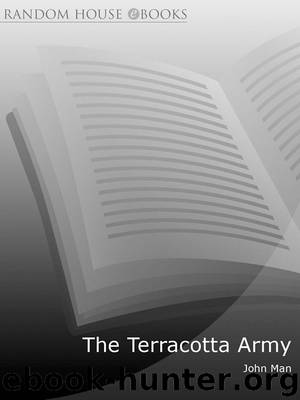The Terracotta Army by John Man

Author:John Man
Language: eng
Format: epub
ISBN: 9781409045618
Publisher: Bantam
Work on the statues began. Not that it was precisely the same as Wang’s in every detail. The Qin sculptors did not use moulds to make the heavy legs, or many of the torsos. These they built up by rolling the clay into long, thin cylinders, coiling these on top of each other and then smoothing out the dents and bumps, the same way as potters make a pot freehand. In some broken figures, the strips of clay are clearly visible. Nor does Wang make horses, which had solid legs, for strength and balance, and bodies that were also made with coils of clay.
Still, the essence of the operation depended on the moulds: ten for heads, four for boots, two for legs, three for shoes. From the modular production process, heads, boots, bodies and legs emerge, still soft from their moulds. Now details must be added; these may be produced from smaller moulds (ears, moustaches, buckles, hairstyles and shoes) or by hand, achieved (as by Wang’s workers today) by refining noses, beards and eyes with scrapers, shavers and sharpened bamboo sticks. In this way, realism is heightened. Indeed, when the figures first came to light the realism seemed so astonishing that it was widely claimed – still is, in the more unthinking brochures – that the warriors were actual portraits of every man in the First Emperor’s army. 3
That would be truly astonishing, for the Chinese had never developed a tradition of portraiture to match Greek or Indian art. There were animals modelled in clay, carved in stone or cast in metals; there were masks; there were superb bronzes, even the occasional figure. Then, later, artists became adept at portraying movement, hairstyles and clothing. But the figures were heavily symbolic. A figure might represent the essence of kingship, but it never occurred to any ruler or any artist to capture the actual features of the king.
Or of the individual soldier. What the sculptors and production workers had to capture was the essence of military ability, which meant exactly the opposite of individuality. As Eleanor von Erdberg says, ‘In these heads there could be no place for any thought other than military discipline and duty. To act as an individual would be gross insubordination.’ Of course, the emperor’s recruiters would have selected the best, rejecting the super-tall, the undersized, the lame, the diseased, the weak. But even for cannon-fodder, or in this case arrow-fodder, entry standards into the real army would have been lower than perfection. Yet in these warriors there are no deformities, no faces disfigured by smallpox, no pimply teenagers, no earless or one-eyed fighters, no gnarled ancients, not a single wound. The army would surely have recruited from every newly conquered land, incorporating for example the tough little horse-riders of the steppes, yet you would be hard-pressed to find racial differ-ences (which are well represented in the little figures in the Han tombs at Yangling). Impeccable hair, neat eyebrows, trim moustaches, every eyelid delineated: they are all suspiciously
Download
This site does not store any files on its server. We only index and link to content provided by other sites. Please contact the content providers to delete copyright contents if any and email us, we'll remove relevant links or contents immediately.
Kathy Andrews Collection by Kathy Andrews(10573)
The remains of the day by Kazuo Ishiguro(7588)
Spare by Prince Harry The Duke of Sussex(4236)
Paper Towns by Green John(4184)
The Body: A Guide for Occupants by Bill Bryson(3843)
Be in a Treehouse by Pete Nelson(3242)
Harry Potter and the Goblet Of Fire by J.K. Rowling(3107)
Goodbye Paradise(2989)
Never by Ken Follett(2922)
Into Thin Air by Jon Krakauer(2718)
The Remains of the Day by Kazuo Ishiguro(2632)
The Genius of Japanese Carpentry by Azby Brown(2621)
The Cellar by Natasha Preston(2611)
Drawing Shortcuts: Developing Quick Drawing Skills Using Today's Technology by Leggitt Jim(2539)
120 Days of Sodom by Marquis de Sade(2452)
Architecture 101 by Nicole Bridge(2359)
Machine Learning at Scale with H2O by Gregory Keys | David Whiting(2335)
The Man Who Died Twice by Richard Osman(2317)
Industrial Automation from Scratch: A hands-on guide to using sensors, actuators, PLCs, HMIs, and SCADA to automate industrial processes by Olushola Akande(2197)
